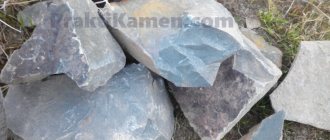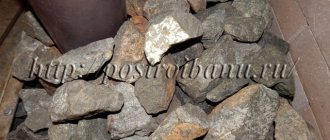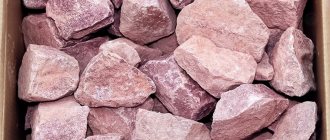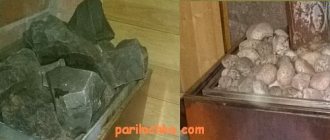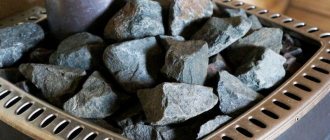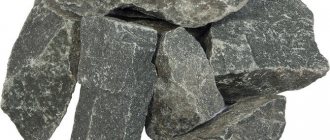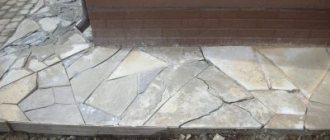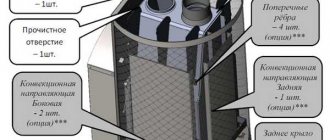A bathhouse is not just a place to relax, but a way to improve your health and well-being. If you choose the right stones for a bath, the beneficial vapors emanating from the hot stones will help cope with diseases and speed up recovery.
But buying to save money increases the risk that the stones will contain radioactive elements and other harmful particles that are life-threatening.
We will talk about all aspects of choosing the appropriate material for a sauna stove and sauna decoration in this article.
Finishing stones
These include breeds that look beautiful, but have poor resistance to temperature changes.
The main function of finishing stones is decorative. They decorate the walls or the outside of the heater. This design will not be cheap, but will last a long time.
Let's look at the most commonly used minerals for cladding.
Amphibolite
Location in our country is Nigrozero. The extraction method is open. The sawing technology is diamond-wire, performed seasonally on the mountainside: this way the blocks are almost the same size and of high quality.
Garnet amphibolite received several names - “Tundra”, “Nordic Sunset”.
The mineral consists of the following components:
- pomegranate – 15%;
- quartz – up to 20%;
- amphibole – up to 35%;
- aegirine – 2%;
- plagioclase – up to 28%.
It has a polychrome color, where black stripes alternate with white splashes and white stripes alternate with black splashes.
Amphibolite is a beautiful stone, therefore it is widely used for cladding:
- fireplaces;
- ovens;
- stairs;
- house facades;
- parapets;
- steps.
This is an excellent raw material for durable tabletops and sculptures.
Among the advantages:
- salt resistance – up to 0.28%;
- water absorption – 0.09%;
- the level of compressive strength reaches 144.4 MPa;
- resistance to low temperatures and wear.
The downside of amphibolite is that it cannot withstand high temperatures and begins to crack.
Marble
Marble finish adds elegance and is suitable for different types of cladding.
The material is durable. Its strength is due to its high quartz content.
Marble is expensive, so not every owner will be able to afford such luxury in the design of a bathhouse.
Jade
The most popular semi-precious mineral. Suitable for finishing work. Found application as a filler for sauna stoves.
Jadeite has a pronounced healing effect:
- Normalizes blood pressure.
- Helps restore the musculoskeletal system.
- Positively affects the functioning of the nervous system and heart.
- Good for the respiratory system.
Its advantages:
- Low thermal conductivity.
- Uniform compression, expansion with temperature changes. Doesn't crack.
- High density.
- Contacting water, saturates it with metasilicon acid.
- When heated, it saturates the air in the steam room with particles of zinc, argentum, and cuprum.
To fill the furnace, you need to take a large polished stone or one that does not need to be embanked - it will last many times longer.
It is allowed to take small crushed or large jadeite as finishing raw materials. The size is selected individually.
Nephritis
Refers to pyroxenes. Semi-precious mineral.
Depending on the mixtures in its composition, the color of the stone can be:
- Emerald or bright green (rich with chrome).
- Dark brown or black (iron predominates).
- Pink (contains magnesium).
Long ago in the East, jade was called a stone of health because of its healing properties and the ability to speed up the treatment of many diseases.
It is used in baths for decorative purposes, to decorate the walls of rooms. Durable, can retain heat for a long time.
When purchasing it, you should be careful, because often, instead of expensive natural jade, sellers offer inexperienced customers a fake - a cheap coil - for the same money. It is similar in color, but has low strength and cannot withstand temperature changes or constant humidity.
Benefits and harms
The healing properties of stones always cause a lot of controversy among professional bathhouse attendants. Porphyrite occupies almost a leading position in the number of doubts.
Most steamers tend to believe that porphyrite cannot release any nutrients or aromas. At the same time, it does not emit toxic poisons into the air, which no longer makes the exposure harmful.
The main benefit comes from the effect of steam on the body. The stone is a kind of accumulator of thermal radiation. Other experts and hobbyists claim that the mineral, when heated, infuses a vapor of “vitamins.” In their opinion, in a volatile form, they quickly penetrate the body through the respiratory system and pores on the skin.
A sauna with porphyrite stone is extremely effective in the treatment of respiratory diseases: sinusitis, sinusitis, otitis. The steam created by porphyrite cleanses the skin, heals joints, and creates an atmosphere of mountain freshness in the steam room.
It is not possible to scientifically prove one or another point of view. Therefore, without specifying the reasons, the following effects from being in a bath with porphyrite are noted:
- relaxation of mind and body;
- easier breathing;
- stabilization of normal blood pressure;
- elimination of spasms;
- relief of pain, including headaches, joint and muscle pain;
- improved blood flow;
- increasing immunity.
Contraindications are common for visiting paired procedures: chronic diseases in the acute stage, viral infections, purulent formations, oncology, pathologies of the heart and brain.
Harm from using defective stones is also noted. Pathogenic microorganisms accumulate in cracks and holes, mold and fungi develop. In volatile form, such impurities become most dangerous. In addition, they may not withstand expansion and fly apart, injuring people with fragments.
Selecting breeds from an environmental safety point of view
Minerals of uniform color are considered safe for health:
- dunites;
- jadeites;
- peridotites.
Cast iron and ceramics are not dangerous.
You should not use stones containing:
- sulfides;
- creosote;
- inclusions of rich red and yellow shades;
- with a metallic sheen.
You cannot collect granite, crushed stone, or paving stones for a bathhouse near highways or railroad tracks.
It is better to buy stones for backfilling in a store and demand quality certificates from sellers, which will indicate that the product has passed radio control.
An excellent option for finishing the walls of a steam room is salt stones. Beneficial vapors will protect against possible allergens.
Laying features
The stones are selected in size depending on the type of stove:
- For open-fire wood stoves and Finnish saunas, stones from 8 to 18 cm are used. The larger the size of the mineral, the longer it retains heat.
- In closed heaters, the main requirement is a size of up to 23 cm.
- To fire electric furnaces, you need to take minerals measuring 4–7 cm. The recommended diameter of cast iron balls is 80 mm.
- To properly fill a cast iron pot, it is important to select a filler that is smaller in size than the door.
To ensure good, thick steam in the bathhouse, stones are selected and placed as follows:
- Inspect each element for cracks, sharp corners or chips.
- Suitable stones are washed with water and dried. This is an important point, otherwise, instead of clean steam, the owners will receive steam with dust impurities.
- The bottom is laid out with large cobblestones, which heat up quickly and retain heat for a long time. Soapstone, basalt, cast iron balls, gabbro-diabase are suitable. A budget option is river pebbles.
- Next come medium and small valuable species with medicinal properties. Often they combine crimson with white quartzite and jadeite.
- Oblong specimens should be placed vertically so that they heat up faster.
- All elements are placed tightly to each other, but the gaps for air circulation should remain less than 15% of the volume of the stones.
- When placing filler in an electric heater, you do not need to place the stones close to the pipes or other parts, but always 5–8 cm above the heating elements. Otherwise, the heated minerals will begin to expand and may cause the breakdown of one of the elements.
- 1-2 times a year it is recommended to inspect the filling, remove damaged, broken minerals, fill the oven with new ones, wash and dry the stones.
- Some rocks emit a characteristic cracking sound when first heated. If after several heatings the sound does not disappear, then you should get rid of such cobblestones, since there is a high probability of harmful impurities in the composition.
Only hot water can be poured onto hot stones in small portions. Do not pour oils, honey or other solutions to improve the aroma. The flame will increase, and the stones will begin to smoke and create unpleasant smoke.
It is much safer to dissolve essential oils in water and place the container over the stove.
When quantity is important
The role of stones in a steam room largely depends on its type and model of heater. For small electric heaters weighing 10-20 kg, stones are needed not for steam generation, but to protect heating elements from overheating and people from hard infrared radiation from metal. With such a volume, even heat-intensive stones will only smooth out temperature fluctuations, but will not be able to accumulate much heat.
As the volume of the heater increases, careful selection of stones plays an increasingly important role. The general rule is: the more stones in the stove, the longer they will maintain the temperature in the steam room and the more high-quality steam you can get from them. Moreover, by changing the type of stones, you can significantly change the characteristics of the heater itself. For example, for a 200kg stove, jade can provide additional hours of steaming after the fire goes out compared to quartz.
Therefore, try to choose a larger stove and always completely fill the entire volume of the heater with stones. Of course, if you like a Russian bath, and not a Finnish dry-heat sauna.
What stones are not suitable for steam rooms, decoration
The key factor when choosing is appearance. The surface must be uniform, without colored inclusions, mica, or impurities of other rocks.
It is forbidden to mine rocks for a sauna heater near industrial facilities, railway tracks, or highways. Rocks that remain in such places for a long time become saturated with creosote, a toxic substance whose vapors lead to poisoning.
Acidic, sedimentary rocks with a high silica content are not suitable for steam rooms.
Some minerals are used in the decoration of bathhouses, but are absolutely not suitable for filling the heater due to the fact that they begin to crack under the influence of high temperatures (amphibolite).
And, for example, beautiful rhodonite (shown in the photo) is not at all suitable for use in a bathhouse, since it deteriorates when it comes into contact with water.
Rules for using the heater
When using the heater, special attention must be paid to safety rules. Thus, if there are stones with dirt or carbon deposits in the heater, they must be removed, washed thoroughly, allowed to dry and placed back in the oven. If the bathhouse is used quite often, then every 3 months it is worth carefully inspecting the breed for defects and damage.
To obtain steam, the rock must be watered with hot water without adding essential oils. As a rule, all additives are poured into a separate heat-resistant container, mixed with water and placed on the stones. This approach minimizes the amount of carbon deposits and increases the service life.
Comparative characteristics of stones
Based on the performance characteristics, a rating of a number of minerals has been compiled according to several parameters.
By service life
| Place in the ranking | Duration of operation |
| 1 | Nephritis |
| 2 | Dunit, cast iron cores |
| 3 | Chromite, porphyrite, ceramic balls |
| 4 | Raspberry quartzite |
| 5 | Jade |
| 6 | Soapstone chlorite |
| 7 | White quartz |
| 8 | Jasper, gabbro-diabase |
It is important to remember that contact of minerals with open fire, improper placement inside the furnace, or extreme heat leads to a significant reduction in service life and premature damage.
By heat capacity, strength and density
Comparative characteristics of the main indicators of the physical and mechanical properties of minerals used in heater stoves of Finnish saunas and Russian baths.
| Indicators | Jade | Basalt | Gabbro-diabase | Raspberry quartzite | Soap chloride | Porphyrite |
| Compressive strength kg/sq.cm | 20 | over 30 | 15 | 25 | 8 | 15 |
| Mohs hardness | 7 | 8 | 5-6 | 7 | 2-3 | 6 |
| Strength coefficient on a 20-point scale according to Protodyakonov | 20 | 20 | 15 | 20 | 8 | 15 |
| Specific heat capacity kJ/kg*C | 0,88 | 1,1 | 0,7 | 0,95 | 0,98 | 0,85 |
| Thermal conductivity coefficient, kcal m*h*C | 2,3-3,6 | 1,8-3,5 | 1,59-2,98 | 3,7-7,6 | 3,5-4,7 | 1,17-3,37 |
| Coefficient of linear thermal expansion 10³*1/С | 0,35-0,46 | 0,6 | 0,7 | 0,15 | 0,2 | 0,8 |
| Rock density 10³ kg/m3 | 3,2 | 2,9-3,25 | 2,9-3,0 | 2,6-2,8 | 2,8-3,0 | 2,6-2,9 |
| Porosity | 0,01-0,03 | 0,02 | 0,2 | 0,1 | 0,3 | 0,15 |
| Melting temperature | 1040-1060 | 1450 | 1250 | 1700 | 1600 | 1300 |
| Acidity module | 28 | 2,2 | 3,4 | 16 | 1 | 3,5 |
| Class of building materials | 1 | 1 | 1 | 1 | 1 | 1 |
| Heat resistance (heating-cooling cycles) | 400 | more than 1000 | 300 | 100 | 500 | 400 |
| Flaws | SiO2 content more than 50% | No | Sulfur content | Crumbles, SiO2 content is more than 50% | Content of sulfur, talc, flake flaking | Dirty gray color |
It is not recommended to use minerals containing more than 50% SiO2 in baths and saunas.
Before filling the kiln, it is recommended to always check the heat resistance of the stones. To do this, they are heated 2-3 times and lowered into a container with cold water. Elements that have cracked are removed.
Application
Porphyrite is not incredibly beautiful like some other stones. It is not used for laying out decorative inserts, forming entire walls and floors, or for making furniture and interior items. This mineral is not relevant for tactile spa treatments: massages and spot heating.
Mainly, porphyrite has a purely practical value for creating good steam. They line furnace bodies and chimneys. Also, a scattering is made around the heating apparatus and placed directly into the firebox.
In different types of heaters, porphyrite behaves differently:
- closed - the stones do not come into contact with the fire, are placed in a container to isolate them from the flame, covered with a lid or closed with a damper. The heating temperature is about 400C, which implies sharp cooling with water. The steam is light. The service life of porphyrite is 2-3 years depending on the frequency of use.
- direct heating (flow-through) - the fire comes into contact with the stones, and after sufficient heating it is extinguished. Water is poured onto the hot stones. The steam is moist and light. Porphyrite lasts at best 1-1.5 years with moderate use. It is better to place a thick layer of stainless steel under the porphyry. Heating will be slower, but service life will be longer.
- in an open container - a container without a lid or door. The stones are still insulated from the flames. Porphyrite produces heavy steam, since the upper layer does not heat above 100C. In a sauna, such steam spreads more easily due to higher humidity. Service life – 2-4 years.
Wear of porphyrite can be identified by fine dust on the bottom of the heater. When destroyed, it begins to crumble like sand.
Rules for caring for stones
It is important to carry out regular cleaning and inspection.
The need to replace the stove filler may be indicated by the appearance of an unpleasant odor, minimal heat transfer, or poor steam formation.
In regularly used saunas, minerals are inspected every month.
Care instructions:
- Clean off dirt with a metal brush.
- Rinse in a container with clean water without using soap solution or powder.
- A clean stone should be left in water for up to 1.5 hours until it becomes slippery.
- It is recommended to dry the minerals in a well-ventilated area, otherwise fungus will begin to form on the surface.
- Each element should be lightly tapped with a hammer. A loud sound indicates durability and serviceability, a dull sound indicates the need for replacement.
- Cracked specimens must be removed, filling the oven with new ones.
- Oil stains are practically impossible to remove, so the stones are placed with the clean side up.
For a pleasant aroma inside the steam room, you can hang bouquets of lavender and mint on the walls, fill a container with water and essential oil and hang it over the stove.
Top 5 stones for sauna stove
After analyzing the technical characteristics and healing properties of various minerals, we can come to the conclusion that the best choice for a bath would be:
- Jade. Suitable for cladding the walls of a steam room and as a filler for a stove. Durable, with high heat capacity and long service life. It has a good effect on health and helps cope with many diseases.
- Porphyrite and ceramic balls. They have the same thermal conductivity and heat capacity. They have a positive effect on the immune, nervous, and cardiovascular systems. Eco-friendly. Placed on the top layers of the oven.
- Dolerite. Good for backfilling. Keeps warm for a long time. Lasting. Steam has antibacterial properties.
- Soapstone chlorite. A very valuable type of mineral. Able to keep warm for a day. Helps with many diseases. But its service life is limited, so the material is laid on top and requires frequent inspection.
- Basalt. Requires careful inspection before installation for foreign inclusions. Inexpensive, environmentally friendly. Stacked down. It is better to fill the top with more valuable rocks.
What is porphyrite for a bath?
The stone is formed from volcanic rock and is similar in composition to jadeite. It contains silica, oxides of aluminum, calcium, magnesium, and iron. The structure of porphyrite is uneven, granular, and includes large inclusions. In most cases, it is a gray stone, but yellow, white, and pink colors are also found.
The unique qualities of the mineral have been known since ancient times - the ability to conserve heat and have a positive effect on the body. As a bath stone, porphyrite is one of the best. It is durable, does not crumble, does not crack due to its volcanic origin.
The mineral is mined in Siberia and the Caucasus, in Bashkiria and the Kazakh steppes, in Ukraine and the Far East. It is noted that in different regions the stones differ in their characteristics. But its geographical distribution and affordable price make porphyrite accessible to most steam room lovers.


